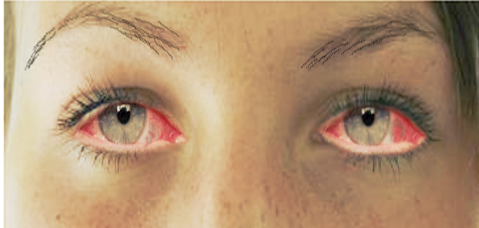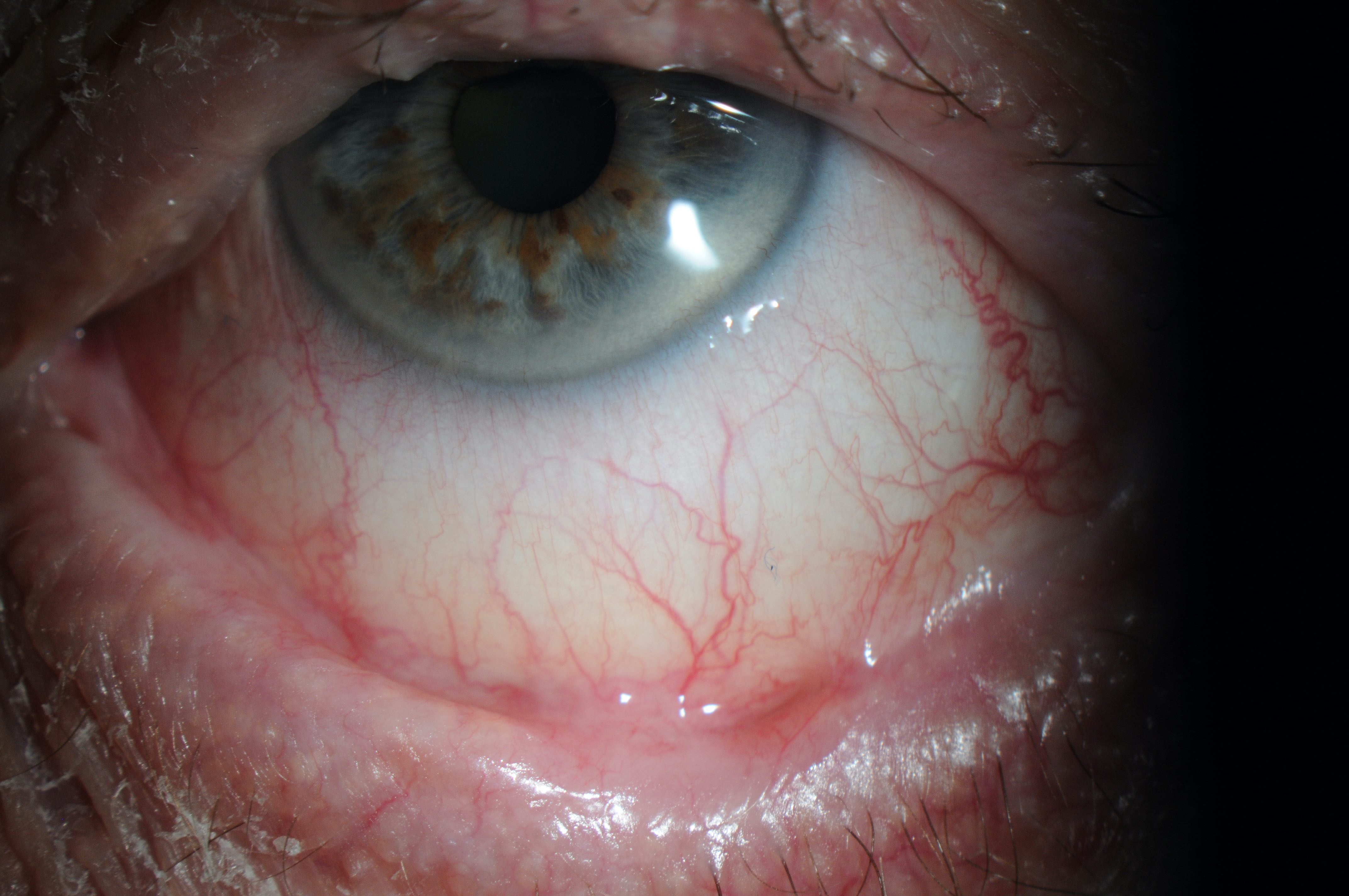[1]
Keen M, Thompson M. Treatment of Acute Conjunctivitis in the United States and Evidence of Antibiotic Overuse: Isolated Issue or a Systematic Problem? Ophthalmology. 2017 Aug:124(8):1096-1098. doi: 10.1016/j.ophtha.2017.05.029. Epub
[PubMed PMID: 28734327]
Level 1 (high-level) evidence
[2]
Udeh BL, Schneider JE, Ohsfeldt RL. Cost effectiveness of a point-of-care test for adenoviral conjunctivitis. The American journal of the medical sciences. 2008 Sep:336(3):254-64. doi: 10.1097/MAJ.0b013e3181637417. Epub
[PubMed PMID: 18794621]
[3]
Rietveld RP, ter Riet G, Bindels PJ, Schellevis FG, van Weert HC. Do general practitioners adhere to the guideline on infectious conjunctivitis? Results of the Second Dutch National Survey of General Practice. BMC family practice. 2007 Sep 16:8():54
[PubMed PMID: 17868475]
Level 3 (low-level) evidence
[4]
Everitt H, Little P. How do GPs diagnose and manage acute infective conjunctivitis? A GP survey. Family practice. 2002 Dec:19(6):658-60
[PubMed PMID: 12429670]
Level 3 (low-level) evidence
[5]
Li J, Lu X, Jiang B, Du Y, Yang Y, Qian H, Liu B, Lin C, Jia L, Chen L, Wang Q. Adenovirus-associated acute conjunctivitis in Beijing, China, 2011-2013. BMC infectious diseases. 2018 Mar 20:18(1):135. doi: 10.1186/s12879-018-3014-z. Epub 2018 Mar 20
[PubMed PMID: 29558885]
Level 2 (mid-level) evidence
[6]
Sow AS, Kane H, Ka AM, Hanne FT, Ndiaye JMM, Diagne JP, Nguer M, Sow S, Saheli Y, Sy EHM, De Meideros Quenum ME, Ndoye Roth PA, Ba EA, Ndiaye PA. [Senegalese experience with acute viral conjunctivitis]. Journal francais d'ophtalmologie. 2017 Apr:40(4):297-302. doi: 10.1016/j.jfo.2016.12.008. Epub 2017 Mar 23
[PubMed PMID: 28342559]
[7]
Azari AA, Barney NP. Conjunctivitis: a systematic review of diagnosis and treatment. JAMA. 2013 Oct 23:310(16):1721-9. doi: 10.1001/jama.2013.280318. Epub
[PubMed PMID: 24150468]
Level 1 (high-level) evidence
[8]
Chigbu DI, Labib BA. Pathogenesis and management of adenoviral keratoconjunctivitis. Infection and drug resistance. 2018:11():981-993. doi: 10.2147/IDR.S162669. Epub 2018 Jul 17
[PubMed PMID: 30046247]
[9]
Trinavarat A, Atchaneeyasakul LO. Treatment of epidemic keratoconjunctivitis with 2% povidone-iodine: a pilot study. Journal of ocular pharmacology and therapeutics : the official journal of the Association for Ocular Pharmacology and Therapeutics. 2012 Feb:28(1):53-8. doi: 10.1089/jop.2011.0082. Epub 2011 Sep 14
[PubMed PMID: 21916618]
Level 3 (low-level) evidence
[10]
Levinger E, Slomovic A, Sansanayudh W, Bahar I, Slomovic AR. Topical treatment with 1% cyclosporine for subepithelial infiltrates secondary to adenoviral keratoconjunctivitis. Cornea. 2010 Jun:29(6):638-40. doi: 10.1097/ICO.0b013e3181c33034. Epub
[PubMed PMID: 20458220]
[11]
Berisa Prado S, Riestra Ayora AC, Lisa Fernández C, Chacón Rodríguez M, Merayo-Lloves J, Alfonso Sánchez JF. Topical Tacrolimus for Corneal Subepithelial Infiltrates Secondary to Adenoviral Keratoconjunctivitis. Cornea. 2017 Sep:36(9):1102-1105. doi: 10.1097/ICO.0000000000001279. Epub
[PubMed PMID: 28704319]
[12]
Arici C, Mergen B. Late-term topical tacrolimus for subepithelial infiltrates resistant to topical steroids and ciclosporin secondary to adenoviral keratoconjunctivitis. The British journal of ophthalmology. 2021 May:105(5):614-618. doi: 10.1136/bjophthalmol-2020-316196. Epub 2020 Jun 20
[PubMed PMID: 32563992]
[13]
Sheikh A, Hurwitz B, van Schayck CP, McLean S, Nurmatov U. Antibiotics versus placebo for acute bacterial conjunctivitis. The Cochrane database of systematic reviews. 2012 Sep 12:(9):CD001211. doi: 10.1002/14651858.CD001211.pub3. Epub 2012 Sep 12
[PubMed PMID: 22972049]
Level 1 (high-level) evidence
[14]
Langford MP, Anders EA, Burch MA. Acute hemorrhagic conjunctivitis: anti-coxsackievirus A24 variant secretory immunoglobulin A in acute and convalescent tear. Clinical ophthalmology (Auckland, N.Z.). 2015:9():1665-73. doi: 10.2147/OPTH.S85358. Epub 2015 Sep 10
[PubMed PMID: 26392747]
[15]
Zhang L, Zhao N, Huang X, Jin X, Geng X, Chan TC, Liu S. Molecular epidemiology of acute hemorrhagic conjunctivitis caused by coxsackie A type 24 variant in China, 2004-2014. Scientific reports. 2017 Mar 23:7():45202. doi: 10.1038/srep45202. Epub 2017 Mar 23
[PubMed PMID: 28332617]
[16]
Huang C, Wang Y, Li X, Ren L, Zhao J, Hu Y, Zhang L, Fan G, Xu J, Gu X, Cheng Z, Yu T, Xia J, Wei Y, Wu W, Xie X, Yin W, Li H, Liu M, Xiao Y, Gao H, Guo L, Xie J, Wang G, Jiang R, Gao Z, Jin Q, Wang J, Cao B. Clinical features of patients infected with 2019 novel coronavirus in Wuhan, China. Lancet (London, England). 2020 Feb 15:395(10223):497-506. doi: 10.1016/S0140-6736(20)30183-5. Epub 2020 Jan 24
[PubMed PMID: 31986264]
[17]
Danesh-Meyer HV, McGhee CNJ. Implications of COVID-19 for Ophthalmologists. American journal of ophthalmology. 2021 Mar:223():108-118. doi: 10.1016/j.ajo.2020.09.027. Epub 2020 Sep 22
[PubMed PMID: 32976847]
[18]
Binder AM,Biggs HM,Haynes AK,Chommanard C,Lu X,Erdman DD,Watson JT,Gerber SI, Human Adenovirus Surveillance - United States, 2003-2016. MMWR. Morbidity and mortality weekly report. 2017 Oct 6
[PubMed PMID: 28981484]
[19]
Alfonso SA, Fawley JD, Alexa Lu X. Conjunctivitis. Primary care. 2015 Sep:42(3):325-45. doi: 10.1016/j.pop.2015.05.001. Epub 2015 Jul 29
[PubMed PMID: 26319341]
[20]
Chintakuntlawar AV, Chodosh J. Cellular and tissue architecture of conjunctival membranes in epidemic keratoconjunctivitis. Ocular immunology and inflammation. 2010 Oct:18(5):341-5. doi: 10.3109/09273948.2010.498658. Epub
[PubMed PMID: 20735288]
[21]
Marinos E, Cabrera-Aguas M, Watson SL. Viral conjunctivitis: a retrospective study in an Australian hospital. Contact lens & anterior eye : the journal of the British Contact Lens Association. 2019 Dec:42(6):679-684. doi: 10.1016/j.clae.2019.07.001. Epub 2019 Jul 9
[PubMed PMID: 31300283]
Level 2 (mid-level) evidence
[22]
Narayana S,McGee S, Bedside Diagnosis of the 'Red Eye': A Systematic Review. The American journal of medicine. 2015 Nov
[PubMed PMID: 26169885]
Level 1 (high-level) evidence
[23]
Sethuraman U, Kamat D. The red eye: evaluation and management. Clinical pediatrics. 2009 Jul:48(6):588-600. doi: 10.1177/0009922809333094. Epub 2009 Apr 8
[PubMed PMID: 19357422]
[24]
Elnifro EM, Cooper RJ, Klapper PE, Yeo AC, Tullo AB. Multiplex polymerase chain reaction for diagnosis of viral and chlamydial keratoconjunctivitis. Investigative ophthalmology & visual science. 2000 Jun:41(7):1818-22
[PubMed PMID: 10845603]
[25]
Kaufman HE. Adenovirus advances: new diagnostic and therapeutic options. Current opinion in ophthalmology. 2011 Jul:22(4):290-3. doi: 10.1097/ICU.0b013e3283477cb5. Epub
[PubMed PMID: 21537185]
Level 3 (low-level) evidence
[26]
Kam KY, Ong HS, Bunce C, Ogunbowale L, Verma S. Sensitivity and specificity of the AdenoPlus point-of-care system in detecting adenovirus in conjunctivitis patients at an ophthalmic emergency department: a diagnostic accuracy study. The British journal of ophthalmology. 2015 Sep:99(9):1186-9. doi: 10.1136/bjophthalmol-2014-306508. Epub 2015 Mar 30
[PubMed PMID: 25824258]
[27]
Sambursky R, Trattler W, Tauber S, Starr C, Friedberg M, Boland T, McDonald M, DellaVecchia M, Luchs J. Sensitivity and specificity of the AdenoPlus test for diagnosing adenoviral conjunctivitis. JAMA ophthalmology. 2013 Jan:131(1):17-22. doi: 10.1001/2013.jamaophthalmol.513. Epub
[PubMed PMID: 23307204]
[28]
Holtz KK, Townsend KR, Furst JW, Myers JF, Binnicker MJ, Quigg SM, Maxson JA, Espy MJ. An Assessment of the AdenoPlus Point-of-Care Test for Diagnosing Adenoviral Conjunctivitis and Its Effect on Antibiotic Stewardship. Mayo Clinic proceedings. Innovations, quality & outcomes. 2017 Sep:1(2):170-175. doi: 10.1016/j.mayocpiqo.2017.06.001. Epub 2017 Jul 25
[PubMed PMID: 30225413]
Level 2 (mid-level) evidence
[29]
Jhanji V, Chan TC, Li EY, Agarwal K, Vajpayee RB. Adenoviral keratoconjunctivitis. Survey of ophthalmology. 2015 Sep-Oct:60(5):435-43. doi: 10.1016/j.survophthal.2015.04.001. Epub 2015 May 5
[PubMed PMID: 26077630]
Level 3 (low-level) evidence
[30]
Usher P, Keefe J, Crock C, Chan E. Appropriate prescribing for viral conjunctivitis. Australian family physician. 2014 Nov:43(11):748-9
[PubMed PMID: 25551873]
[31]
Shiota H, Ohno S, Aoki K, Azumi A, Ishiko H, Inoue Y, Usui N, Uchio E, Kaneko H, Kumakura S, Tagawa Y, Tanifuji Y, Nakagawa H, Hinokuma R, Yamazaki S, Yokoi N. [Guideline for the nosocomial infections of adenovirus conjunctivitis]. Nippon Ganka Gakkai zasshi. 2009 Jan:113(1):25-46
[PubMed PMID: 19227929]
[32]
Özen Tunay Z, Ozdemir O, Petricli IS. Povidone iodine in the treatment of adenoviral conjunctivitis in infants. Cutaneous and ocular toxicology. 2015 Mar:34(1):12-5. doi: 10.3109/15569527.2014.888077. Epub 2014 Mar 31
[PubMed PMID: 24678746]
[33]
Kovalyuk N, Kaiserman I, Mimouni M, Cohen O, Levartovsky S, Sherbany H, Mandelboim M. Treatment of adenoviral keratoconjunctivitis with a combination of povidone-iodine 1.0% and dexamethasone 0.1% drops: a clinical prospective controlled randomized study. Acta ophthalmologica. 2017 Dec:95(8):e686-e692. doi: 10.1111/aos.13416. Epub 2017 Mar 25
[PubMed PMID: 28342227]
Level 1 (high-level) evidence
[34]
Faraldi F, Papa V, Rasà D, Santoro D, Russo S. Netilmicin/dexamethasone fixed combination in the treatment of conjunctival inflammation. Clinical ophthalmology (Auckland, N.Z.). 2013:7():1239-44. doi: 10.2147/OPTH.S44455. Epub 2013 Jun 24
[PubMed PMID: 23836952]
[35]
Levine J, Snyder RW. Practical ophthalmic microbiology. Journal of ophthalmic nursing & technology. 1999 Mar-Apr:18(2):50-9; quiz 74-5
[PubMed PMID: 10409996]


